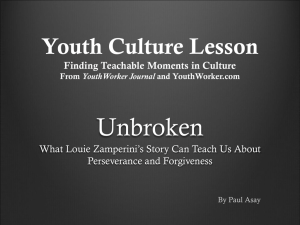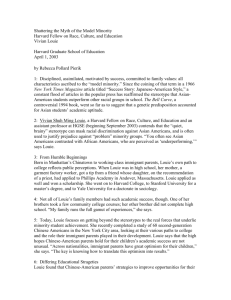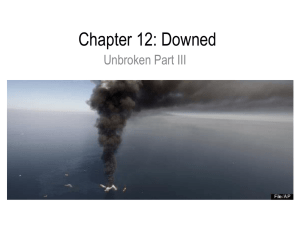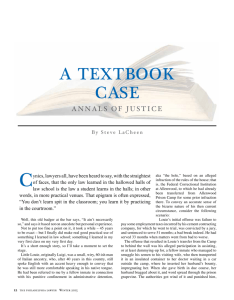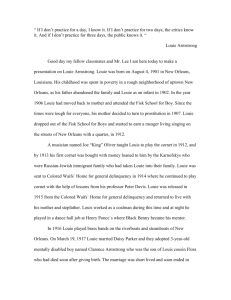Louie-NMSLC1102 - The Nevada Seismological Laboratory
advertisement
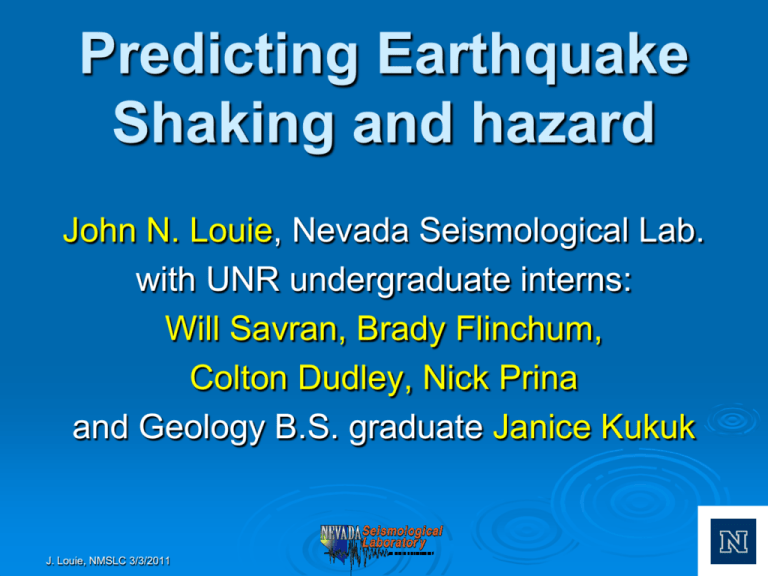
Predicting Earthquake Shaking and hazard John N. Louie, Nevada Seismological Lab. with UNR undergraduate interns: Will Savran, Brady Flinchum, Colton Dudley, Nick Prina and Geology B.S. graduate Janice Kukuk J. Louie, NMSLC 3/3/2011 Last Week’s Earthquake in Christchurch, New Zealand Magnitude 6.3 aftershock of M 7.1 in Sept. J. Louie, NMSLC 3/3/2011 Unexpectedly Intense Ground Shaking Horizontal accelerations >2 times gravity J. Louie, NMSLC 3/3/2011 What Happens with Such Intense Shaking? >200 deaths, 1/3 of city’s buildings destroyed J. Louie, NMSLC 3/3/2011 Stuff.co.nz Could It Happen Here? It Already Did! Wells, Nevada, Feb. 2008 Photos by Marilyn Newton, Reno Gazette-Journal How Do We Protect Nevada’s People and Economy from Earthquakes? Stiffen building codes to strengthen buildings everywhere? But, would make construction too costly Improve our understanding of earthquake shaking What areas have high hazard? Put resources there. Don’t waste money reinforcing safer areas J. Louie, NMSLC 3/3/2011 Three Elements to Predicting Shaking (1) Where are the earthquake sources? Discover and locate faults with seismic monitoring and surveying Characterize faults with geology and seismic surveying (2) How will the waves propagate from the sources? Characterize basins with gravity and seismic surveying (3) How will the soils under your property react? Scenario predictions with “Next-Level ShakeZoning” Seismic microzonation with Parcel Mapping Use physics and geology to get realistic shaking predictions for likely earthquakes Combine predictions with probability of each earthquake Nevada researchers are working on these challenges. J. Louie, NMSLC 3/3/2011 Adding Fault Geology Black Hills Fault in Google Earth with USGS Qfaults trace J. Louie, NMSLC 3/3/2011 Adding Geology & Geotechnical Data Black Hills Fault in Google Earth with USGS Qfaults trace Earthquake Magnitude from Fault Size J. Louie, NMSLC 3/3/2011 M0 = μAd μ = 3x1011 dyne/cm2 A = Fault Area (cm2) = (9 km length)(105 cm/km) (9 km width)(105 cm/km) d = fault displacement = 200 cm (from geologists) Adding Geotechnical Data ShakeZoning Geotech Map Obtained by Clark Co. and City of Henderson • 10,721 site measurements • J. Louie, NMSLC 3/3/2011 Adding Physics 2nd-order PDE controls P(x,y,z) wave’s evolution in time Uses Laplacian to get spatial derivatives Use definition of derivative to compute a Finite Difference (don’t take limit) J. Louie, NMSLC 3/3/2011 Wave Computation on a 3D Geological Grid Fine grid gives accurate FD estimate of derivatives Finer grid takes longer to compute, higher cost Finer grid for higher shaking frequencies J. Louie, NMSLC 3/3/2011 Adding Physics Black Hills M6.5 event Short trace but 4-m scarps noted Viscoelastic finitedifference solution 0.5-Hz frequency 0.20-km grid spacing A few hours on our small cluster Map view of waves Mode conversion, rupture directivity, reverberation, trapping in basins J. Louie, NMSLC 3/3/2011 Showing 3-D Vector Motions 3 computed components of the ground particle velocity vector: (x, y, z) 3 components of color on your computer screen: (R, G, B) red, green, blue J. Louie, NMSLC 3/3/2011 Showing 3-D Vector Motions 3 computed components of the ground particle velocity vector: (x, y, z) 3 components of color on your computer screen: (R, G, B) red, green, blue J. Louie, NMSLC 3/3/2011 from MathWorks.com Showing 3-D Vector Motions 3 computed components of the ground particle velocity vector: (x, y, z) 3 components of color on your computer screen: (R, G, B) red, green, blue J. Louie, NMSLC 3/3/2011 Showing 3-D Vector Motions 3 computed components of the ground particle velocity vector: (x, y, z) 3 components of color on your computer screen: (R, G, B) red, green, blue J. Louie, NMSLC 3/3/2011 Showing 3-D Vector Motions 3 computed components of the ground particle velocity vector: (x, y, z) 3 components of color on your computer screen: (R, G, B) red, green, blue J. Louie, NMSLC 3/3/2011 Showing 3-D Vector Motions Add the color components to get a perceived color Color depends on strength and direction of wave vibration J. Louie, NMSLC 3/3/2011 Adding Physics Cue up and play: BH-ClarkCo-0.5Hz.m4v Timelapse animation 60 seconds wave propagation compressed to 16.6 sec video Time compression factor of 3.6 J. Louie, NMSLC 3/3/2011 Adding Physics Cue up and play: BH-ClarkCo-0.5Hz.m4v 0 seconds after rupture begins on the Black Hills fault (9 km down) Las Vegas basin in shaded relief J. Louie, NMSLC 3/3/2011 FM LV H BH Adding Physics Cue up and play: BH-ClarkCo-0.5Hz.m4v 2.2 seconds after rupture begins on the Black Hills fault FM LV H BH Seismic waves reach the surface in Eldorado Valley J. Louie, NMSLC 3/3/2011 Adding Physics Cue up and play: BH-ClarkCo-0.5Hz.m4v 6.9 seconds after rupture begins on the Black Hills fault P wave in Las Vegas, small (dark yellow) Intense surface waves funneling into Henderson J. Louie, NMSLC 3/3/2011 FM LV H BH Adding Physics Cue up and play: BH-ClarkCo-0.5Hz.m4v 13.4 seconds after rupture begins on the Black Hills fault Rayleigh wave in W. Las Vegas, large (redblue) Like ocean wave: vertical in between radial motions J. Louie, NMSLC 3/3/2011 FM LV H BH Adding Physics Cue up and play: BH-ClarkCo-0.5Hz.m4v 23.9 seconds after rupture begins on the Black Hills fault Rayleigh wave carrying energy to Pahrump Much energy left behind in soft geologic basins J. Louie, NMSLC 3/3/2011 FM LV H BH Adding Physics Cue up and play: BH-ClarkCo-0.5Hz.m4v 45.2 seconds after rupture begins on the Black Hills fault Rock areas like FM insulated from shaking Shaking trapped in basins, radiating out J. Louie, NMSLC 3/3/2011 FM LV H BH Black Hills M6.5 Scenario Results Max Peak Ground Velocity (PGV) >140 cm/sec PGV over 60 cm/sec (yellow) bleeds into LVV by Railroad Pass Large event for a short fault Geologists are divided on likelihood Need to know how likely J. Louie, NMSLC 3/3/2011 Frenchman Mountain Fault M6.7 Scenario Possible Scarp in Neighborhood J. Louie, NESC 2/9/2011 Event Inside the LVV Basin Frenchman Mountain Fault M6.7 Scenario Event Inside the LVV Basin Cue up and play: FMF_ClarkCo_0.5Hz_24fps.m4v Timelapse animation 60 seconds wave propagation compressed to 24 sec video Time compression factor of 2.5 J. Louie, NMSLC 3/3/2011 2-Segment Frenchman Mtn. Fault M6.7 J. Louie, NESC 2/9/2011 2-Segment Frenchman Mtn. Fault M6.7 All of Las Vegas Valley shakes as hard as Wells in 2008 (20 cm/s) Higher shaking in areas of refraction and focusing Less shaking in west Valley: stiffer soil J. Louie, NMSLC 3/3/2011 We Are Computing Dozens of Scenarios J. Louie, NESC 2/9/2011 Combine the Scenarios Probabilistically λ = annual frequency of exceeding ground motion u0 rate(M, sourcej) = annual rate of occurrence for an earthquake with magnitude M at source location j P = probability of ground motions u ≥ u0 at site i, if an earthquake occurs at source location j with magnitude M J. Louie, NMSLC 3/3/2011 US Geological Survey Hazard Maps On line at http://earthquake. usgs.gov/hazards / Mostly from past earthquakes No wave physics J. Louie, NMSLC 3/3/2011 Faul t Model Setup •Two Basin-Thickness Datasets: •Widmer et al., 2007 Washoe Co. gravity model •Saltus and Jachens 1995 gravity model •Two Geotech Datasets: •Pancha 2007 ANSS station measurements •Scott et al., 2004 shallow shear-velocity transect Scenario Fault (like 2008 Wells): •Strike: N-S •Motion: Normal- down to the west •Length: 7.58 km •Mw: 5.94 (Anderson et al., 1996) •Frequency: 0.1 Hz and 1.0 Hz Physics-Based Wave Propagation 0.1 Hz Model 1.0 Hz Model • Cue up and play DowntownReno-1Hz-5.04M.m4v • The basin amplifies and traps seismic shaking • Wave propagation unaffected by basin dataset boundaries in the 0.1 Hz Model • Wave propagation is affected by basin dataset boundaries in the 1.0 Hz Model- but not in basin Peak Ground Velocities (PGV) Max PGV: 22 cm/s Max PGV: 46 cm/s

